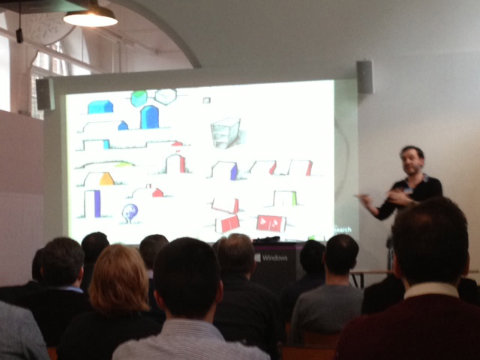How annoying is the British three-pin plug? Companies like Apple design the slimmest, lightest, most beautiful products but hanging off the end of them is a great big lump, with scratchy sticks on it. This is what designer Min-Kyu Choi realised. He took his own experience, a moment of friction, and used it to inspire a genuinely innovative product. This is disruptive design. [youtube http://www.youtube.com/watch?v=O8UfsmItoX4]
Fortune and favour recently shone upon me and I had the opportunity to attend a Microsoft event at Modern Jago at London's Silicon Roundabout. It's title: Design-led Innovation. Yes, when I first heard about this event, aimed at 'change agents', I was not convinced that it was fortune and favour that had shone upon me. The dress code of 'relaxed but with intent' pretty much convinced me that the day would be full of words without meaning. I could not have been more wrong.
That plug story is a perfect example of design-led innovation. Speakers like Mat Hunter, Chief Design Officer at the Design Council, and Richard Banks, researcher at Microsoft Labs in Cambridge, enthused on the ability that design has to be disruptive. Take a step back and question your brief, or your initial assumptions, and you can discover an entirely new question to be answered. As Mat Hunter said about development of the 'hot tap' (no, I hadn't come across it before either, but then, mine is not the salary-bracket this event was aimed at), "No one ever wanted the kettle, they just wanted hot water."
This is what the Design Council calls the 'double diamond' design process. Most people and companies stay within the first diamond, but disruptive design stops and interrogates the assumptions behind the brief. The crux of the idea: make your brief better before you answer it.
That single idea has continued to flash and flicker for me. It is the process that allows things to be more beautiful, more apt and more seamlessly integrated into our personal stories.
Richard Banks' presentation about his research on the relationship between physical objects, digital objects, histories and recontextualising content was both fascinating and moving. The idea that perhaps a physical, wooden box, holding 40 years worth of tweets, could sit in a home and have the same sentimental and historical importance that a family photo album or a collection of diaries could have was brilliant. His focus started with people, not products, and the design worked back from there. "Technology always ends up screaming technology," he said, so they worked with natural materials to allow the important content and meta data that digital histories contain to be naturally present in people's homes.
These ideas, these people - they got me excited. I was already a fan of the Co.Design online magazine, but understanding a little more about the relationship between business and design, their articles and visuals resonate more deeply. Design is not about an isolated way of shaping a product or creating the appearance of a website: it is the process of understanding why you are designing in the first place. Every speaker at Microsoft's event came back to the human element. It is always an individual interacting with any piece of design or product, and they have a narrative, which it fits into. Design is not abstract.
Whilst the beauty and excitement of these ideas is fantastic enough, I also love the fact that it can apply to writing. I came across a quote once, (I forget where), that I always try to keep in mind:
Write to someone who will not let you off the hook - who will question and force you to refine and clearly define your point.
Excellent advice and exciting ideas all round.

